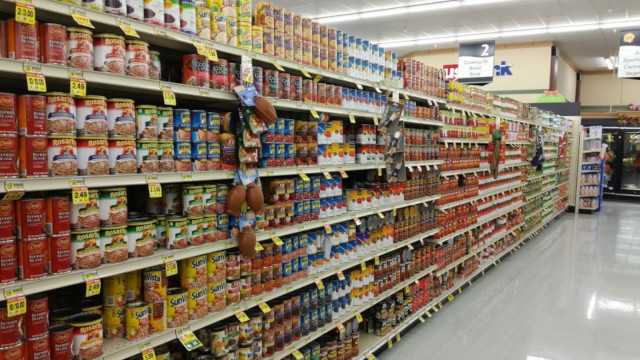Public health officials are now saying that the spread of COVID19 – the official name of the Novel Coronavirus that has massive areas in China locked down – is inevitable. They are recommending we all think about stockpiling at least two weeks of healthy food in case of a panic run…
 Canned foods are still very much a part of many folks’ lives. They still get one
Canned foods are still very much a part of many folks’ lives. They still get one
or more entire aisles to themselves in most supermarkets.
And they’re great for long-storage situations.
The question, say health officials, is not if, but when COVID19 will start to spread more widely. Already ‘community transmission’ cases have been reported in the U.S. and elsewhere; cases in which the patient didn’t visit an infection hotspot or come in contact (knowingly) with a carrier. So, it’s time to look at how to thoughtfully stockpile food for 2 to 4 weeks – in preparation for the worst-case scenario.
What shuts down and what keeps working?
In the event of a massive COVID19 infection, stores, offices, factories, warehouses and delivery services could shut down. But electricity, water and gas delivery should not be affected. So, if we stock-in enough healthy food to last us at least two weeks, we should not have to worry about washing and cooking it, or about the viability of freezer storage. That’s the good news. The bad news is, there’s no way that most Fresh Produce bought today would last 2 weeks without spoiling. We must also consider what we like to eat (cultural and religious dietary restrictions come into play, here, too), and whether it’s available in a form that facilitates storage, either in the freezer or on the pantry shelf.
Long shelf life is important
Choose foods that have a long shelf life, even after being opened. Dry foods such as Noodles, Lentils, Oatmeal, Cornmeal Masa, Wheat Flour, and Dried Beans are all good examples of foods that will last almost forever on the shelf as long as they’re closed tightly again after opening. I use regular clamp-style paper clips from the office supply store to make sure my bagged dry goods remain at their best. No wonder Dry Foods are at the top of the most-request lists of Food Banks, along with Canned Goods.
Canned (and Jarred) food is a wonderful invention. The first canned food was commissioned by Napoleon so that his armies could feast on Fruits and Veggies, Stews and other foods, rather than being limited to Bacon, Beans, and Hard Tack (and whatever they could scavenge) while in the field. The technology has advanced continually over the last 200 years, to the point that you can find almost any Fruit, Veggie, Fish or Meat you want in a can. And those cans have shelf lives of years. However… Canned foods are all cooked (in water or their own sauce) during the canning process, and may lose colour, flavour and nutritional value when you discard the water they come in. However, Soups, Stews, Pasta Sauces and similar foods not canned in disposable water may also contain a significant amount of added Salt, as a preservative, and to make up for the inherent flavour loss.
The freezer is your best friend when it comes to storing Meats and Veggies for long periods of time. You can find a wide variety of Fruits and Veggies in the freezer section of your supermarket, and you can also freeze fresh Meats as long as you take care to wrap them tightly in two layers of plastic wrap excluding as much air as possible from the package. If you freeze meats in the plastic wrapped foam trays they come in , you’ll be risking freezer burn and drastically reducing the storage life of the product. The great thing about frozen veggies is, they were frozen right from the field and are really in suspended animation, with all their flavour, colour and nutrients waiting for you when they are thawed.
MREs should not be a consideration
Unless you’re stockpiling for the Apocalypse or planning to sit out the aftermath of a nuclear war in your bomb shelter, don’t bother with MREs (Meals, Ready to Eat). Those are the meals-in-a-pouch the army gives soldiers in the field. Just add Water and heat. But you would get them at outdoor stores where campers and survivalists shop. There’s lots of variety available, but they’re not that great; perhaps acceptable when you’re otherwise starving. They are, however, formulated to contain all the vital vitamins and other nutrients you need to keep going.
What about your pets?
Remember your pets! Dry cat and dog kibbles are available in large sized bags and can be stored for weeks tightly closed. Moist foods come frozen or in pouches but must be used on a one-container-per-feeding basis. Wet foods come canned and are favoured by many pets. But this is the second most expensive way to feed your best friends, after Moist foods.
And don’t forget the Treats! Your pets will no doubt suffer cabin fever over a two-week or longer period if you limit their outdoors activities. A good supply of their favourite Treats can go a long way to alleviating their discomfort.
I’ve learned from experience
Having sat out a 6-day blackout during a major ice storm, I know what it’s like to not only be short on food, but to not have the means to cook it. I heartily recommend you stock up on the food you like now, in storage formats you can handle – just in case worst comes to worst. But I also ask you to remember that your COVID19 ‘self quarantine’, if it comes to that, would last a minimum of 14 days and up to a month. Don’t go out in a panic, and clear the shelves of your supermarket. There’s plenty to go around!
~ Maggie J.

